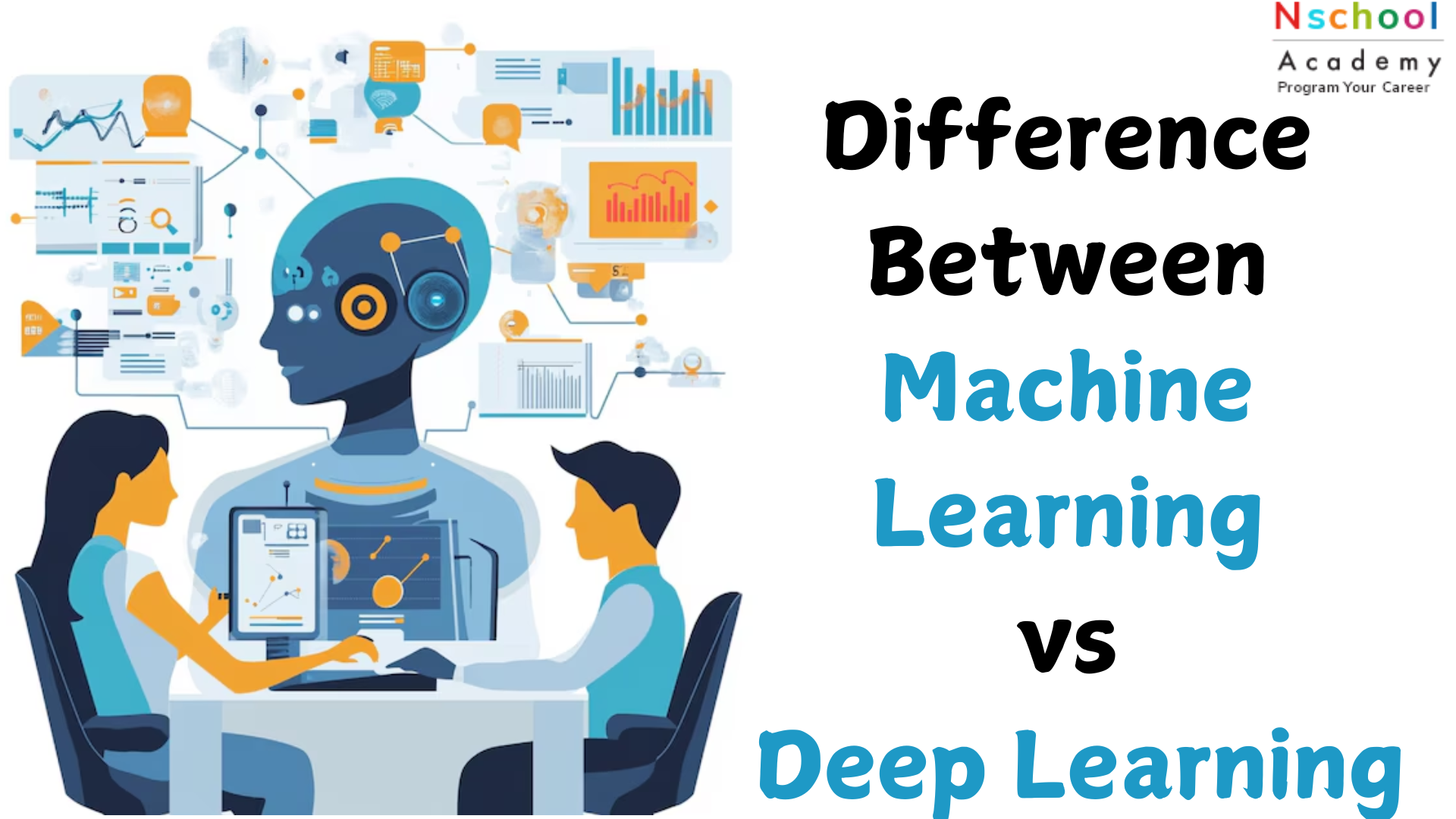Machine learning vs Deep learning
- September 20, 2024
- nschool
- 0

Introduction
Machine learning vs deep learning, the two significant subdivisions of artificial intelligence, are currently at the frontline in transforming business organizations by creating innovative tools to automate various tasks. Artificial Intelligence, involving systems finding out how to solve problems using data without being programmed to do so is known as Machine Learning. It has been around for several decades Deep Learning is a relatively younger branch that uses artificial neural-like our brain. It is widely accepted due to its higher accuracy in certain problems such as picture identification, language translation, and the like.
Here, we’ll go through the fundamental differences between Machine Learning vs Deep Learning, how they operate, where they are used, and what their positions are in different fields. By understanding these differences, you will be aware of which approach is appropriate for certain problems and, therefore, make wise decisions when it comes to applying AI solutions.
What is Machine Learning?
Definition and Historical Context
There are two main categories of AI where one is Machine Learning, which makes a system capable of learning from experiences on its own without being programmed. Machine Learning was introduced in the 1950s, it is based on the concept of machines learning from patterns and evolving.
Types of Machine Learning
Supervised Learning: This kind of learning involves feeding the models with data that has been labeled which means that the input data comes with the correct output in mind. These outputs are expected and these algorithms are developed to predict such values from new values that are fed into the algorithms
Examples include:
- Linear Regression: Applied to models that predict variables like house prices that are continuous.
- Decision Trees: Decision-making tools that analyze data and categorize it based on input features.
- Unsupervised Learning: Contains no assignments to categories. In this scenario, the goal is to uncover hidden patterns within the data. Popular algorithms include:
- K-means Clustering: Divide data into subgroups according to the resemblance.
- Principal Component Analysis (PCA) reduces the number of features while preserving the most important information from the dataset.
- Reinforcement Learning: This type is used with agents that know how to behave in a certain environment by performing certain actions and in return are rewarded or punished. It is widely applied in-game AI, such as the famous game AlphaGo, and robotics
Parts of Machine Learning Models
- Features: The ingredients with which inputs are learned by the model.
- Labels: Dependent variables, which the model is expected to forecast.
- Training and Validation Sets: Training and testing of models for accuracy.
Applications of Machine Learning
- Healthcare: It means early diagnosis by using predictive models based on the patient data information.
- Finance: Detecting fraud and enabling high-speed trade execution.
- Retail: Creation of target consumer market segments through consumer database analysis.
- Autonomous Vehicles: Self-driving cars that are built with an integrated system to adapt to their environment.
What is Deep Learning?
Overview of the Definition and Evolution of AI from Machine Learning
The next level of Machine Learning is known as Deep Learning, which works in a way akin to the functioning of the human brain. It is modeled after artificial neural networks designed to replicate the behavior of neurons in the human brain.. Machine Learning uses algorithms that are programmed to work on data while Deep Learning enables the systems to learn on their own from the raw data without much human input.
Neural Networks: The Foundation of Deep Learning
Neural networks form the core of Deep Learning and they are made of nodes or neurons that pass information through weighted connections. Deep Learning networks can be many-layered, hence the name ‘deep’, with every layer containing further more complex features.
Popular Deep Learning Architectures
- Convolutional Neural Networks (CNNs): Highly effective for image recognition tasks. In this network, convolution layers filter and detect spatial hierarchies of features in images.
- Recurrent Neural Networks (RNNs): It is used for structured data in use for sequential data like time series or natural language. They have the ability to store previous inputs to produce future output: this makes them suitable for operations such as speech recognition.
- Generative Adversarial Networks (GANs): Are composed of two neural networks (generator and discriminator), which are in opposition to generating the data from random inputs. GANs can be applied in content generation, for example in producing paintings or even genuine photos
Use Cases of Deep Learning
- Facial Recognition: Implemented in security technologies and social media apps.
- Speech Synthesis: Siri or Alexa or any speaker-to-listener converter is a classic example that depends on the DL models for human vocal understanding and creation.
- Autonomous Driving: Self-driving cars use Deep Learning to assess the environment and respond to it by identifying objects and conditions on the roads.
Machine Learning vs Deep Learning
Aspect | Machine Learning | Deep Learning |
Data Requirements | Most effective with small working sets. Features are manually extracted from raw data. | Sensitive to the type of data used for training due to the enormity of the neural networks. |
Feature Engineering | Requires manual training for pre-processing, feature selection, and extraction. | Allows feature extraction directly from raw data without manual engineering. |
Model Interpretability | Algorithms like decision trees and linear models are less opaque and easier to understand. | Neural networks are considered black-box models, making it difficult to explain decisions. |
Hardware Requirements | Can be executed on conventional microprocessors with minimal processing capacity. | Requires specific hardware, such as GPUs, for training neural networks. |
Training Time | Usually takes less time, especially with relatively small datasets. | May take longer to train, particularly with deep architectures and large datasets. |
Accuracy | Excels in simpler problems, such as binary classification on well-digitized data (e.g., tabular data). | Outperforms in complex applications like image recognition, speech recognition, and natural language understanding. |
A detailed explanation of the interworking of Machine Learning and Deep Learning
- Hybrid Models
Often, the applications of Machine Learning and Deep Learning are complementary to each other. For instance, Deep Learning can be used in feature extraction, then Machine Learning tools for classification or regression. - Transfer Learning
In Transfer Learning, instead of training the Deep Learning model from the very beginning, it is trained on a related task and re-used. For instance, a CNN pre-trained on a large dataset for image classification can be fine-tuned on a small specialized dataset.
Some real-life examples of combined ML and DL include the following:
- Google Search Algorithms: Google employs the methods of Machine Learning and Deep Learning networks to improve the search algorithm.
- Predictive Maintenance: Specifically, the integration of ML algorithms and DL models allows for analyzing sensor data and predicting when machines will fail.
Machine learning vs deep learning and their applications in specific industries
| Industry | Machine Learning (ML) | Deep Learning (DL) |
|---|---|---|
| Healthcare | Early identification of diseases and grouping patients for treatment. | Image-based diagnostics, e.g., identifying cancerous tumors in MRI scans. |
| Finance | Identifying fraudulent transactions using anomaly detection algorithms. | Forecasting market movements using unstructured data like news articles and social trends. |
| Autonomous Systems | Basic control tasks like lane maintenance in automobiles. | Advanced tasks like object identification in autonomous vehicles. |
| Marketing & Advertising | Customer segmentation and recommendation systems. | Real-time delivery of ads driven by consumer behavior. |
Challenges and Constraints of Machine Learning
- Overfitting and Underfitting: Machine learning models may fit the training data noise rather than the signal or may fail to capture important features in training data.
- Feature Engineering: The identification of the relevant features is an important step in the process, and this is not always simple or apparent.
- Data Requirements: Despite this, it should be noted that, although ML can operate on comparatively small sets of data, its performance significantly drops when data is scarce or contains much noise.
Main Uses and Benefits of Deep Learning
- High Computational Cost: Training deep networks is computationally intensive and can only be done if one has access to fairly powerful machines such as GPUs.
- Large Data Requirements: Most of the DL models require a massive volume of labeled data for the training processes.
Interpretability: One of the challenges with Deep Learning models is that they lack transparency, which complicates the explanation of their choices. - Environmental Concerns: The amount of energy used in training large neural networks has been a subject of worry in terms of sustainability.
The Future of Machine Learning and Deep Learning
Trends in Machine Learning
- AutoML: Simplifies the application of Machine Learning as it helps in deploying it without the need for a specialist.
- Edge Computing: A widening use of ML models on edge equipment such as hand-held devices to curb time and enhance effectiveness.
Trends in Deep Learning
- Model Efficiency: Recent models, such as GPT-4 and BERT, are more efficient and, therefore, have better results when applied to different tasks involving text.
- Advancements in Reinforcement Learning: Continued advancements in RL such as in games, robots, and industries.
Ethical Considerations
Given the growing adoption of ML and DL models, there is an emerging question concerning ethical issues, such as bias, privacy, and accountability for decisions made by AI systems.
Conclusion
Superclass Machine Learning vs Deep Learning are subcategories of Artificial Intelligence which has its benefits and drawbacks. This is why while Machine Learning is used more often for certain actions that work with structured data, Deep Learning optimizes and improves upon in more complex cases with large amounts of unstructured data. Thus, knowing when to implement one or the other will help businesses and researchers utilize the potential of AI to bring more value and transform various industries.
Moving into the future, the interconnectivity between Machine Learning and Deep learning is set to progress through technology integration and will lead to innovations across various fields thereby revamping the overall human existence with new advancements.

